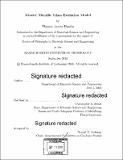Kinetic metallic glass evolution model
Author(s)
Hardin, Thomas J., 1988-
DownloadFull printable version (14.13Mb)
Other Contributors
Massachusetts Institute of Technology. Department of Materials Science and Engineering.
Advisor
Christopher A. Schuh.
Terms of use
Metadata
Show full item recordAbstract
The structure of metallic glass controls its mechanical properties; this structure can be altered by thermomechanical processing. This manuscript presents a model for this structural evolution of metallic glass under thermal and mechanical stimuli. The foundation of this model is a potential energy landscape; this consists of three pieces: a function for the energy of any given stable state, a density of states function across the landscape, and a model for the energetic barriers between stable states. All three of these pieces are parameterized in terms of the configurational potential energy of the glass, which is split into isochoric and dilatative degrees of freedom. Under a thermal or mechanical stimulus, the glass traverses the potential energy landscape by way of isotropic relaxation or excitation events, and by shear transformations. The rates of these events are calculated using transition state theory. This model is first implemented in homogeneous form, treating the glass nanostructure as a statistical distribution; this implementation, while devoid of spatial detail, is nonetheless able to fit many of the experimental results on homogeneous flow previously in the literature. The second implementation of the model is in a mesoscale discrete shear transformation zone dynamics framework; this couples the model's rate equations to discrete points in a finite element model under realistic thermomechanical loading, and propagates the effects of local events via static elasticity. Emphasis is placed on efficient computer implementation of the new model's physics, improving on the previous state of the art with stiffness matrix factor caching and geometric multigrid methods. These numerical improvements produce a 200x speedup over previous algorithms, enable rapid simulations of glass with evolving elastic properties, and facilitate the first-ever metallic glass simulations of physical nanomechanical experiments with matching length and time scales.
Description
Thesis: Ph. D., Massachusetts Institute of Technology, Department of Materials Science and Engineering, 2018. Cataloged from PDF version of thesis. Includes bibliographical references (pages 213-227).
Date issued
2018Department
Massachusetts Institute of Technology. Department of Materials Science and EngineeringPublisher
Massachusetts Institute of Technology
Keywords
Materials Science and Engineering.